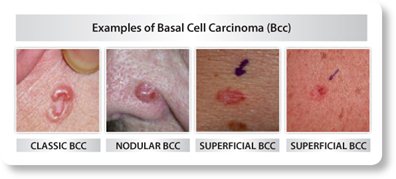
BCC is the most common form of skin cancer. Millions are diagnosed each year and nearly all are cured with treatment.
What BCC Looks Like
- Dome shaped growth with visible blood vessels
- Shiny, pinkish patch
- Sore that heals, then returns and repeatedly heals and returns
- Brown or black growth
- White or yellow waxy growth that looks like a scar
Most BCCs develop on sun exposed skin such as the scalp, neck and hands. It is especially common on the face – on the nose, cheeks and forehead but can develop anywhere on the body.
Risk Factors For BCC
Anyone can get BCC, but there are risk factors that make it more likely that you will be diagnosed with BCC at some point in your life. Lighter skinned people tend to develop BCC more frequently. Damage to the skin occurs through UV exposure, either from the sun or from tanning beds. Over time, this damage accumulates and increases the risk of developing skin cancer. The risk does increase with age because the older you are, the longer you have been exposed to UV radiation.
Risk Factors:
- Pale, light colored or freckled skin
- Blond or red hair
- Blue, green or gray eyes
- Family history of skin cancer
- A weakened immune system or are taking medications that suppress the immune system
- Received radiation therapy
- Used tanning beds or other indoor tanning devices
BCC is serious because it can grow deep enough to affect bone or other tissue. It rarely spreads to other areas of the body, however. A deep or invasive BCC can be difficult to treat.
If caught and treated early, BCC is highly curable. Treatment cures most BCCs. To diagnose a BCC a biopsy will be performed. This is the only way to diagnose any type of skin cancer. The biopsy will be performed under local anesthesia, which means that the area of skin to be biopsied will be numbed with injections of lidocaine. The tissue sample will then be sent to a pathologist to be examined under a microscope. If the diagnosis is BCC, there are many factors that will determine the appropriate treatment.
Treatment Options for BCC
- Excision – Surgical procedure to remove the BCC along with normal looking skin to ensure that all of the cancer cells have been removed. This is sent to the pathologist for confirmation of clear margins, which means that there are no remaining cancer cells in that tissue that remains. If the normal looking skin contains cancer cells, more treatment is necessary.
- Mohs micrographic surgery – Mohs is usually performed at a medical office under local anesthesia while you remain awake. The skin cancer, along with some normal looking skin is removed. The sample is then examined under the microscope to determine whether or not cancer cells remain, and where those cells are. This will direct the surgeon as to where to remove more skin sample, if necessary. This process continues until there are no cancer cells remaining.
- Radiation – When surgery cannot be performed, radiation therapy may be recommended. A series of radiation treatments are performed to destroy the cancer cells.
- Medication applied to the skin – When BCC is caught very early and is superficial, medication may be applied to the skin at home to destroy cancer cells.